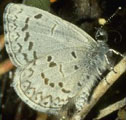Native Plants
Search for native plants by scientific name, common name or family. If you are not sure what you are looking for, try the Combination Search or our Recommended Species lists.
Viburnum lentago
Viburnum lentago L.
Nannyberry, Blackhaw, Sweet Viburnum, Sheepberry
Caprifoliaceae (Honeysuckle Family)
Synonym(s): Viburnum ×vetteri
USDA Symbol: VILE
USDA Native Status: L48 (N), CAN (N)
A tall viburnum, occasionally growing as a small tree, 20-30 ft. tall. Slender, erect-arching branches, somewhat open at maturity, often suckering. Attractive white flower clusters, dense dark-green summer foliage, wine-red fall color, blue-black berries which persist through winter. Shrub or small tree with short trunk, compact, rounded crown of drooping branches, small white flowers in clusters, and small bluish-black fruit.
When cut, the plants sprout from roots, and old branches will often arch down and take root. Songbirds, gamebirds, and mammals eat the fruit in winter.
Plant Characteristics
Duration: PerennialHabit: Shrub
Leaf Retention: Deciduous
Fruit Type: Drupe
Size Notes: Up to about 30 feet tall.
Leaf: Green
Autumn Foliage: yes
Fruit: Black, Blue
Bloom Information
Bloom Color: WhiteBloom Time: Apr , May , Jun
Distribution
USA: CO , CT , DE , GA , IA , IL , IN , MA , MD , ME , MI , MN , MO , MT , ND , NE , NH , NJ , NY , OH , PA , RI , SD , VA , VT , WI , WV , WYCanada: MB , NB , ON , QC , SK
Native Distribution: Que. to Man. & MT, s. to VA & n.e. MO, e. NE & WY
Native Habitat: Rich, open woods; hillsides; stream banks
Growing Conditions
Water Use: MediumLight Requirement: Sun , Part Shade , Shade
Soil Moisture: Moist
Soil pH: Circumneutral (pH 6.8-7.2)
CaCO3 Tolerance: Low
Soil Description: Moist to dry soils.
Conditions Comments: Adaptable to a wide range of conditions. Sometimes develops mildew in shady areas.
Benefit
Use Wildlife: Squirrels, Birds.Conspicuous Flowers: yes
Fragrant Flowers: yes
Attracts: Birds , Butterflies
Larval Host: Spring Azure
Butterflies and Moths of North America (BAMONA)
|
Spring Azure (Celastrina "ladon" )  Larval Host |
Propagation
Seed Collection: Collect the fruit as soon as it has turned a dark blue-black color. Store seeds with pulp on at 41 degrees.Seed Treatment: If seeds must be stored, they will need a period of stratification.
Commercially Avail: yes
National Wetland Indicator Status
| Region: | AGCP | AK | AW | CB | EMP | GP | HI | MW | NCNE | WMVE |
| Status: | FAC | FAC | FAC | FACU | FAC | FAC | FACU |
From the National Organizations Directory
According to the species list provided by Affiliate Organizations, this plant is on display at the following locations:Mt. Cuba Center - Hockessin, DE
Bibliography
Bibref 1186 - Field Guide to Moths of Eastern North America (2005) Covell, C.V., Jr.Bibref 1185 - Field Guide to Western Butterflies (Peterson Field Guides) (1999) Opler, P.A. and A.B. Wright
Bibref 946 - Gardening with Prairie Plants: How to Create Beautiful Native Landscapes (2002) Wasowski, Sally
Search More Titles in Bibliography
Web Reference
Webref 23 - Southwest Environmental Information Network (2009) SEINet - Arizona ChapterAdditional resources
USDA: Find Viburnum lentago in USDA PlantsFNA: Find Viburnum lentago in the Flora of North America (if available)
Google: Search Google for Viburnum lentago
Metadata
Record Modified: 2022-10-11Research By: TWC Staff